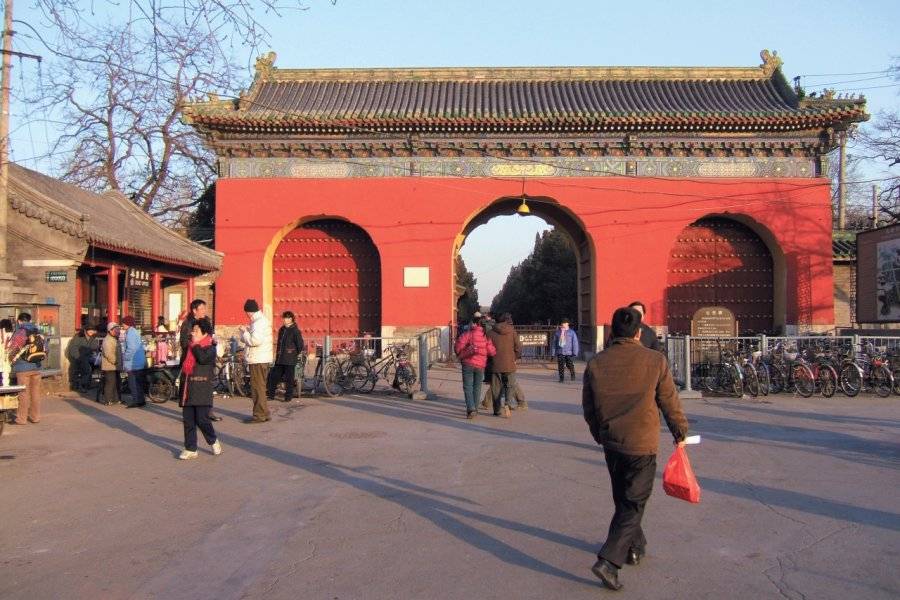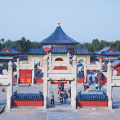One of the best places in Beijing to admire the Chinese practicing Qi quan, the exercises of qi gong, singing, dancing and other morning gymnastics.
History
Located in the south of the city in an immense park of 273 ha, this ensemble, designed under the Ming, was to be directly connected to the sky. Hence an extremely strong essoterism: colors, geometrical shapes (traditionally, the circle represents the sky and square, land), sounds, differences in height of buildings.
Incarnation of the Ming architecture to its closest degree to perfection, the Temple of Heaven gradually became the symbol of the Chinese capital. The tradition regarded the Emperor as the son of heaven, and as such he had to visit and sacrifice to his father, the Sky, and his ancestors, if he wanted to preserve harmony between the human order and the cosmic order. This is where the emperors of the Ming dynasty and Qing came, twice a year (15 th day of the 1 st lunar month and the day of the winter solstice), to worship the heavens and pray for a good harvest.
Originally, heaven and earth were both venerated in this temple, and in 1530 the temple of the earth (Ditan) was built north of Beijing. The emperor was escorted from Qian Men to the Temple of Heaven by his soldiers and ministers, royal blood princes and musicians, dancers and elephants. All doors and windows along his path were closed, because no one had to see the son of heaven.
Architectural forms are direct references to the themes of Heaven and Earth: The hall of Fastinence, or palate of the square, located near the celestial door of the west, is a forbidden city in miniature, while the temple of prayer for the good harvest (Qinian Dian) and the outdoor open air are both linked to heaven.
Visit
To the north of the whole, the temple of prayer for the good harvest is the main building. A triple terrace of 5,900 m 2 in the middle of a square courtyard leads to the temple of conical form. Its triple roof covered with blue tiles melts into the blue mass of the sky. Prodigious technological feat: this gigantic building designed in 1420 is a clever assembly of wooden elements without nail. Symbolism is reflected in the architectural technique itself: This 38 m height structure and 30 m width is supported by 28 solid wooden pillars. The four central pillars represent the four seasons, the first crown of twelve pillars, the months of the year and the second, the hours of the day and night. Each pillar is a massive trunk of cedar in Yunnan province.
The room is directly open to the outside with its wooden latching walls. It was in this room that the sacrifice of the late spring was held. The throne of Heaven (always empty since Heaven could not sit there) was in the center of this room and, after presenting his written prayer asking Heaven that all conditions were harmoniously combined for good harvests, the emperor burned it in a furnace at the foot of the throne. In the pavilions, the gods of the Sun, Moon, Stars and Wind, Rain, Thunder and Eclairs were vented. In the nineteenth century, the lightning fell on the temple which was then reconstructed in 1889.
In front of the temple of prayer to the right harvest, on the north-south axis lies the imperial arch of the sky (Huangqiongyu) with the blue roof topped with a golden ball. This much smaller structure, built in 1530, was designed to receive the shelves of the gods of the Sun and the Moon after the ceremony. The building is surrounded by a completely hermetic wall, the Echos wall, along which the slightest sound runs. In front of the steps leading to the building, the triple sound: all its product from the first stone is reproduced once; second, twice; and the third one, three times. On both sides of the imperial arch of heaven are rectangular buildings now transformed into small museums.
One of them presents an interesting collection of traditional musical instruments and a model reconstituting the processions that followed the emperor during the rites of prayer in the temple.
To the south, the altar of heaven (Huanqiu). Built at the same time as the imperial arch and rebuilt in 1740, this white marble altar is composed of three terraces culminating in the center in a symbolic representation around the imperial figure «9». Nine concentric circles radiate around a central stone: the first circle consists of 9 stones and the outer circle 81 stones. If you are in the middle of the central stone and start talking, your whole body will resonate with vibrations, as a kind of inner echo, experience! In the center of the upper terrace there was also a throne destined for heaven.
The Fasting Hall (Qinggong), located at the east gate. This is where the emperors and their ministers observed a three-day fast before each ceremony. Having dressed a dress embroidered with dragons, the emperor opened the ceremony by burning incense, offered the ancestors and the supreme emperor sacrifices of animals and gifts according to custom, silks, jade tablets… Then a herald read the written prayer of the emperor while as a herald… The latter was prostrated and burned in the furnace with the altar all offerings… as well as the text of prayer addressed to Heaven.
While everything consumed himself was dances, music and songs. Then the emperor went back into his palace in a palanquin different from the one that brought him. Today, the Hall of Fasting has become an exhibition hall presenting various instruments of sacrifice, dating mainly from Qing period.
The temple of heaven is to be visited absolutely. It is with the temple of the Lamas one of the most beautiful in Beijing, and, whatever the season, you will be enchanted by the magic of the places. In order to enjoy the time to enjoy the palaces, the park (with some very old trees quite impressive) and the general ambience of this site, count a big half-day visit. The entire site has been classified as UNESCO's World Heritage Site since 1998.
Did you know? This review was written by our professional authors.
Members' reviews on SKY TEMPLE
The ratings and reviews below reflect the subjective opinions of members and not the opinion of The Little Witty.









